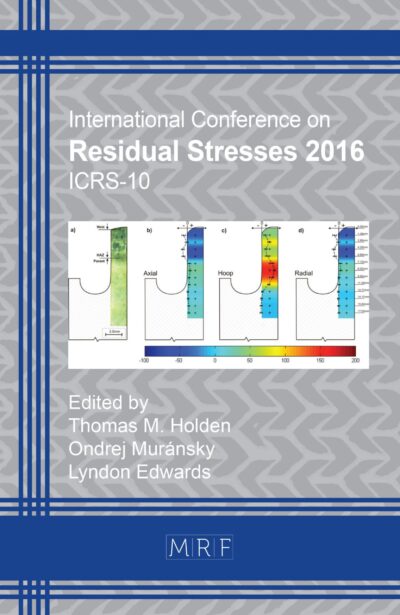Properties evaluation on SiC reinforced aluminum composite under a novel process of cryogenic treatment
Baosheng Liu, Nan Guo, Yuansong Zeng , Ran Pan, Yunhe Chang, Zhiyong Li
Abstract. In this work, a novel process of Cryogenic Treatment and Rapid Heating (CTRH) was proposed to decrease the residual stress and improve the properties of SiC-reinforced aluminum composite. An orthogonal test with parameters of cryogenic preserving time T(h), high-temperature medium (m), circulating times (N), and aging time t(h) was designed. The precipitates and residual stress were detected by TEM and XRD X-ray diffraction. The results show that the strengthening effect mainly comes from the finer and denser uniformly distributed needle-shaped θ'(Al2Cu) phase after CTRH. The process parameters optimized for low residual stress and high strength are T=36 h, circulating boiling water, N=2, and t=30 h.
Keywords
Cryogenic Treatment Process, Aluminum Composite, Properties Evaluation, Residual Stress
Published online 5/7/2025, 9 pages
Copyright © 2025 by the author(s)
Published under license by Materials Research Forum LLC., Millersville PA, USA
Citation: Baosheng Liu, Nan Guo, Yuansong Zeng , Ran Pan, Yunhe Chang, Zhiyong Li, Properties evaluation on SiC reinforced aluminum composite under a novel process of cryogenic treatment, Materials Research Proceedings, Vol. 54, pp 2221-2229, 2025
DOI: https://doi.org/10.21741/9781644903599-239
The article was published as article 239 of the book Material Forming
![]() Content from this work may be used under the terms of the Creative Commons Attribution 3.0 license. Any further distribution of this work must maintain attribution to the author(s) and the title of the work, journal citation and DOI.
Content from this work may be used under the terms of the Creative Commons Attribution 3.0 license. Any further distribution of this work must maintain attribution to the author(s) and the title of the work, journal citation and DOI.
References
[1]H. R. Shakeri,Zhirui Wang, Effect of alternative aging process on the fracture and interfacial properties of particulate Al2O3-reinforced Al (6061) metal matrix composite, Metallurgical and Materials Transactions A 33(2002) 1699-1713. https://doi.org/10.1007/s11661-002-0179-1
[2]C.V. Singh,D.H. Warner, Mechanisms of Guinier–Preston zone hardening in the athermal limit, Acta Materialia 58(2010) 5797-5805. https://doi.org/10.1016/j.actamat.2010.06.055
[3]S.Q. Wang,M. Schneider,H.Q. Ye,G. Gottstein, First-principles study of the formation of Guinier–Preston zones in Al–Cu alloys, Scripta Materialia 51(2004) 665-669. https://doi.org/10.1016/j.scriptamat.2004.06.018
[4]M. Araghchi,H. Mansouri,R. Vafaei, Influence of cryogenic thermal treatment on mechanical properties of an Al–Cu–Mg alloy, Materials Science and Technology 34(2018) 468-472. https://doi.org/10.1080/02670836.2017.1407553
[5]Liping Ma,Wenxiang Zhao,Zhiqiang Liang,Xibin Wang,Lijing Xie,Li Jiao,Tianfeng Zhou, An investigation on the mechanical property changing mechanism of high speed steel by pulsed magnetic treatment, Materials Science and Engineering: A 609(2014) 16-25. https://doi.org/10.1016/j.msea.2014.04.100
[6]Fei Dong,Youping Yi,Shiquan Huang,Bingxiang Wang,Hailin He,Ke Huang,Chenguang Wang, Cryogenic formability and deformation behavior of 2060 Al–Li alloys with water-quenched and T4 aged temper, Materials Science and Engineering: A 823(2021) 141722. https://doi.org/10.1016/j.msea.2021.141722
[7]Mingli Zhang,Ran Pan,Baosheng Liu,Kaixuan Gu,Zeju Weng,Chen Cui,Junjie Wang, The Influence of Cryogenic Treatment on the Microstructure and Mechanical Characteristics of Aluminum Silicon Carbide Matrix Composites, Materials 16(2023) 396. https://doi.org/10.3390/ma16010396
[8]Chen Ding,Li Wenxian, Cryogenic treatment of Al and Al alloys, The Chinese Journal of Nonferrous Metals 10(2000) 891-895. https://doi.org/http://ysxb.csu.edu.cn/thesisDetails?columnId=31315069&Fpath=home&index=0〈=zh












